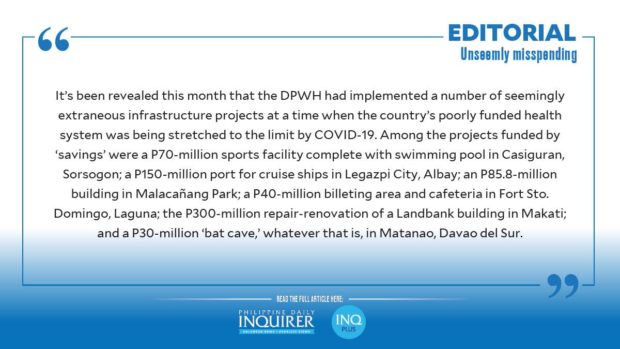
At the Asia Infrastructure Forum 2021 last June, Public Works Secretary Mark Villar said the government’s “Build, build, build” program has so far created 6.5 million jobs, with public infrastructure spending doubled to 5 percent of gross domestic product (GDP) from an average of 2 percent during previous administrations. The government’s infrastructure managers also noted that ongoing projects would create an additional 1.6 million jobs this year.
But while infrastructure spending was indeed ramped up, the program has not been spared missteps. During the Asia Infrastructure Forum, Villar said the pandemic had put pressure on the government’s limited financial resources, which had to be redirected to the urgent COVID-19 response. Some infrastructure projects deemed not among the government’s priorities were set aside for fiscal prudence.
Reprioritizing is one thing. Unwarranted spending is a different story. It’s been revealed this month that the Department of Public Works and Highways (DPWH) had implemented a number of seemingly extraneous infrastructure projects at a time when the country’s poorly funded health system was being stretched to the limit by COVID-19.
Last year’s declaration of a national state of emergency due to the pandemic allowed the Duterte administration to convert some P10.3 billion in contingent funds into savings. Nothing wrong if those funds were spent on pandemic response efforts. However, as flagged by former Bayan Muna party list representative Neri Colmenares, the money went instead to projects irrelevant to the health crisis. “This was the time when the country is in dire need of funds for cash aid, PPE [personal protective equipment], testing and contact tracing, but here we see billions being used for projects that are not urgent,” he lamented.
Among the projects funded by the “savings” were a P70-million sports facility complete with swimming pool in Casiguran, Sorsogon; a P150-million port for cruise ships in Legazpi City, Albay; an P85.8-million building in Malacañang Park; a P40-million billeting area and cafeteria in Fort Sto. Domingo, Laguna; the P300-million repair-renovation of a Landbank building in Makati; and a P30-million “bat cave,” whatever that is, in Matanao, Davao del Sur.
Another issue that has beset the infrastructure program is slower-than-slow spending. Senators last week pointed out that with 2021 coming to a close, Malacañang was still sitting on about P100 billion worth of projects earmarked by lawmakers in the 2021 budget, including funding for medical scholarships and public works. “These projects should already be nearing completion. But until now, most of the projects—which could generate a lot of jobs—have yet to begin while some are yet to be bid out,” Sen. Nancy Binay said at a budget hearing of the Senate finance panel. Senate finance chair Juan Edgardo Angara pointed out that unless obligated by December, the funds would revert to the Bureau of the Treasury. Senate Majority Leader Juan Miguel Zubiri said it would be “such a waste if the funds aren’t released. We need these for countryside development, medical scholarships and different programs.”
Last July, President Duterte’s economic team announced that it has jacked up the yearly public infrastructure programs for 2022 to 2024. The Cabinet-level Development Budget Coordination Committee raised the infrastructure budget for 2022 to P1.29 trillion (or 5.8 percent of GDP) from P1.25 trillion previously. The programmed infrastructure expenditures for 2023 and 2024 were also raised to P1.28 trillion and P1.35 trillion, respectively, from P1.26 trillion and P1.32 trillion earlier. This would allow the share of infrastructure spending to GDP to average 5.4 percent in 2022 to 2024.
The implementation of “Build, build, build” would thus continue to be critical to the country’s long-term economic recovery. The next administration to be elected in the May 2022 polls will have the opportunity to continue and finish the beneficial projects under the program, and revisit those that represent costly, unseemly misspending in the face of far more pressing concerns on other fronts. With the Duterte administration’s reflex aversion to looking into anything questionable in its backyard, and with less than eight months into its term, a thorough scrutiny of the spate of late-breaking extravagant projects under the DPWH may happen only in the next dispensation. But happen it must.

